P55 Extreme Overclockers: Check your sockets!
by Rajinder Gill on October 15, 2009 12:01 AM EST- Posted in
- Motherboards
We start with a picture.

The picture above is after our Core i7 870 (LGA-1156) processor was overclocked up to 5.19GHz using our cascade with a -102° Celsius evaporator head temperature under full-load. Processor VCC power draw at these frequencies is around 160W (this is possible only due to subzero cooling), as measured with a clamp meter installed at the 12V EPS power lead. Study the pictures closely and you should notice something peculiar. Keep in mind it comes from a CPU installed in the same type of socket from a particular manufacturer.
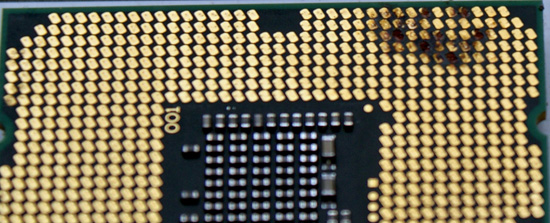
What happens after several extreme benchmark runs...
If you noticed something weird in the pictures then you understand the title of our article. We have what seems to be a potentially serious issue with proper socket loading on several P55-based motherboards when overclocking to the limit. We are of course not the only ones experiencing the problem as several of our overclocking peers have run into the same problem.
Normally we do not worry too much about mishaps during extreme overclocking testing as they are typically caused by factors outside of the supplier’s control. The overriding concern is that we have damaged every motherboard in our possession for the P55 overclocking (extreme) shootout as well as two very expensive i7/870 processors. These problems are the cause of a single component and are repeatable. As such, we thought we would provide details on current problems and will provide an update once all of the motherboard manufacturers affected have had a chance to properly respond.
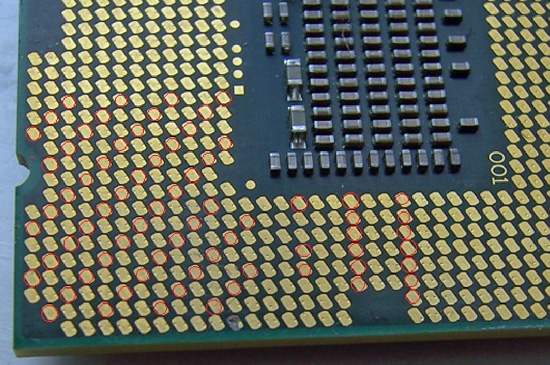
We draw your attention to the fact that the processor shown in this pictures exhibits signs of insufficient pin-to-pad contact (little to no contact) in what is a rather reproducible pattern with Foxconn manufactured 1156 sockets. As soon as an end-user mounts a CPU in a socket and latches the clamp mechanism, each pin should leave a notable mark on the associated pad.
We've marked locations where this does not seem to have happened, showing what appears to be a significant reduction in the number of VCC/VSS pins for proper power delivery, and certainly not at the right load line resistance. Damage resulting from highly overclocked use in these types of situations is not solely limited to the processor; let’s take a look at what happened to some of the motherboards in which these CPU were seated.
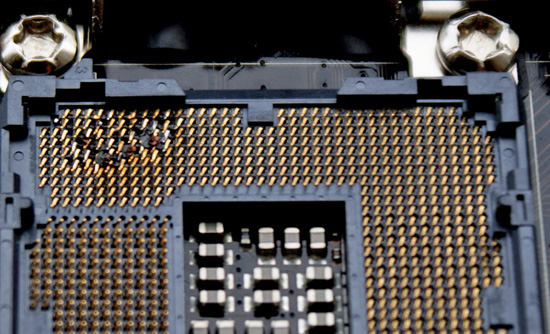

When Intel publishes socket specifications and design tolerances, it's up to component manufacturers to strictly adhere to them when designing, manufacturing, testing and ultimately selling their "compliant" components. Of course, that's not to say Intel could not have goofed when releasing their specification, leaving out a crucial tolerance or such. It could happen, but not likely. For the time being, let's assume that's not the case; seeing as how processors installed in sockets built by other companies have exhibited no such issue in testing to date.
At first glance, one might be inclined to think LGA-1156 based processors are intolerant of high-end overclocking, almost as if by design. This is correct to some extent; a quick glance at Intel’s white papers for socket 1156 CPU’s reveals that there are around 175 pads for VCC compared to over 250 for socket 1366 CPU’s. This means socket 1156 has around 66% of the current capacity of socket 1366, the caveat being that when overclocked, processors from both platforms draw similar levels of current.
When overclocked above 4GHz, processors from both platforms will draw around 15-16 amps via the EPS 12V rail to VCC, VTT and some of the other sub –system power rails under full 8 thread load from the Intel burn test (Linx). Assuming 85% PWM efficiency, we’re looking at power draw in the region of 130-140w to VCC on both platforms. The facts point toward tighter current handling tolerances for socket 1156 when compared to socket 1366, especially when it comes to non-connection of VCC/VSS power delivery pins.
Fortunately, we think we've been able to isolate pin to pad contact issues to one particular brand of parts. Physical inspection and end-user reports all but confirm the issues only affects sockets manufactured by Foxconn at this time. The only known alternative sockets in the wild are made by LOTES or Tyco AMP. We happen to have a couple of boards from EVGA using the LOTES/Tyco AMP sockets and MSI/DFI using the LOTES socket design, and thus far those boards have been issue free given highly similar operating conditions. In fact, we’ve managed to push our LGA-1156 processors further in heavy load tests on boards made using LOTES/Tyco AMP sockets than those made with sockets from Foxconn; something we’re not putting down solely to coincidence.
So far, EVGA is the only company we know that uses sockets exclusively from LOTES on their top-tier P55 boards - for example, the EVGA P55 Classified 200, model E659. This by the way may be the onus behind the decision to market the board’s “300% More Gold Content” socket statement as a purchasing option point. If you find yourself shopping for an EVGA P55 FTW, model E657, you've got a 50/50 chance of buying one with a Tyco AMP socket design (using a LOTES backplate), as opposed to one made solely with Foxconn's, the same goes for MSI and DFI who have batches of boards in the retail channel using LOTES sockets (although we're not entirely sure on socket specifics at this point). DFI told us earlier they have dropped usage of the Foxconn sockets completely until further notice. We hear the LOTES and Tyco AMP sockets are in short supply, which is probably why Foxconn's been able to fill the void in the market with what we believe to be a lower quality alternative for the extreme overclocker.
We took one of our damaged CPU’s and inserted it into one of the EVGA (LOTES/Tyco AMP) boards and took a few pics to show contact scoring and a side by side compare to the original Foxconn socket indents.
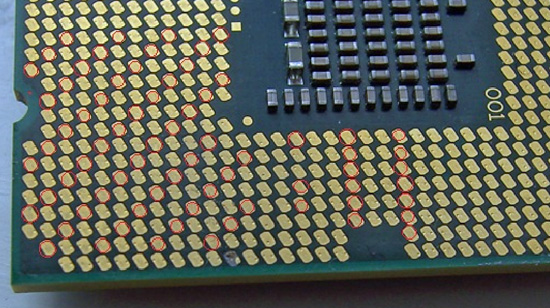
Foxconn 1156 Socket Installation
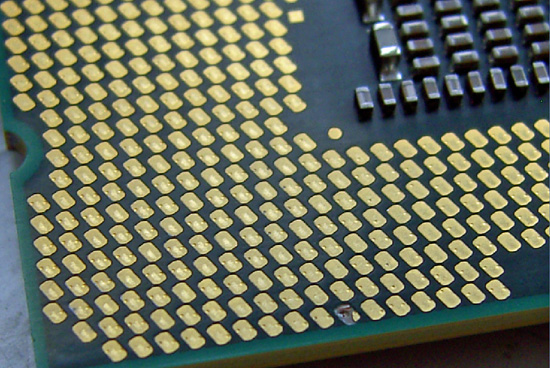
Tyco AMP / LOTES 1156 Socket Installation
Note how from a variety of angles certain pads show no evidence of contact from a Foxconn pin at all. Both the Tyco AMP and LOTES sockets have a larger pin/pad contact surface area leaving a slight scuff mark in the central area of each pad. In light of this, what we will say is that if you’re thinking of doing extreme overclocking on a board built using Foxconn's socket 1156, think again. Or, at least check your CPU for evidence of proper pin-to-pad contact.
We have not had any problems with air or water cooling overclocking up to 4.3GHz, although we do have a i5/750 that has developed a few dark pads after a thousand hours or so of constant overclocking. However, none of the boards have developed pin problems so we feel very safe in saying that any problems will probably occur only in extreme overclocking scenarios.
We also realize that partial responsibility for some of the less than acceptable CPU installations may be in fact due user installation errors. However, if users are screwing this up by doing nothing different than what they've always done when it comes to handling and installing LGA-type processors, then it's hard for us to find fault with the installer. Be aware of this situation and study the pin imprint on the CPU pads and make sure you have good contact on the VCC/VSS power delivery pads before pushing the system too hard.
















273 Comments
View All Comments
ClagMaster - Saturday, October 24, 2009 - link
You're welcome.I like the Scythe SCSK-1100 100mm Shuriken Rev B. For $30 it's a very good CPU heatsink that blows air down on the power electronics. Although it is listed as a LGA775 heatsink, it will also fit LGA1156 too. See the NewEgg and FrostyTech reviews.
That's what I am going to buy next summer for my i5 750/ GA-P55-UD3R.
If you are upgrading from an Athlon XP Barton, an i5 will most definitely not disappoint. This is about 3-4x faster than the Barton in benchmarks.
moronsworld - Friday, October 23, 2009 - link
"Some people have panicked (Lions and Tigers and Bears! Oh my!) at the notion their might be a problem with their motherboards with Foxconn LGA1156 sockets running stock. This has never been proven."Yeah it has never been proven but it has never been unproven either. All I wanna say is, in the cases of non-overclocked stock speeds, only time can tell but I think what most ppl are saying is they don't wanna take that chance. Six months, a year, a year and a half down the road when at stock speeds if the board burns out the cpus thats money and time gone down the hole. I mean sure some motherboard manufacturers might RMA the boards for you but what about the cost of the cpu? they wont cover that. And even with the RMAing of boards some companies will give you hell before they will do it for you. Basically what ppl want are security in what they buy and foxconn doesn't seem to give that. I wouldn't take my chances with foxconn maybe some ppl will but not me, even if i had to pay a little extra to get a non-foxconn socket. With that all said....
From what I read of all your posts you seem like you want to backup foxconn, what's up with that? I mean WTH... Don't tell ppl it will be ok to buy foxconn sockets when you yourself haven't tested over a long period of time and even so testing one motherboard over a long period of time doesn't prove or disprove anything. It can only be proven with many tests with many different foxconn based motherboards. I doubt you have done that. And then you try to say this is not a foxconn issue but an intel issue. So how is it an intel issue when the other sockets aren't having this problem? Seems to me you're a foxconn employee.
moronsworld - Friday, October 23, 2009 - link
Oh yeah and you try to say you know better because you're an Electrical Engineer or whatever but it doesn't take a rocket scientist to figure it out. With basic logic of deduction and common sense anyone can see that foxconn is the problem here.ClagMaster - Saturday, October 24, 2009 - link
I am disinterested in Foxconn. They make decent hardware but I recognize they can slip up.And I am serious about my intentions to purchase an i5 750/GA-P55-UD3R combination next year. Whether it has a Foxconn socket or not I do not care because I will be running stock speeds with a single graphics card. Unless its proven there is a defect in this socket where the CPU cannot contact all of the pins (for reasons stated above) then I see no reason why I should not purchase this combination with a Foxconn socket.
I have been a design engineer for 30 years either designing equipment or solving emergent issues with existing equipment. You need to get your facts straight first before making broad accusations about a peice of hardware or a manufacturer. That is because these have legal ramifications for a variety of reasons. Its clear to me you are immature and ignorant.
One excellent attitude to have while investigating hardware issues is to adopt the principle that hardware is assumed innocent before proven guilty. You need to be critical, of course, but not hypercritical because of fear or a rebellious spirit.
I have found people, including you, to be far more faulty, unreliable and culpable than hardware. People have expectations (oftentimes unreasonable, not grounded in reality, more grounded in popular politics) and these expectations often causes self-deception about responsability, or the severity of the problem.
Because of this, I reject the consumerist supposition that the consumer is aways right. Often consumer is not. Especially when they do stupid things like abuse hardware beyond their capabilities. And when they get hurt because their opportunistic stupidity, they deny their resposability and hire professional manipulators and liars to get the courts to rule the manufacturer responsable (liable) instead.
What I do not like to see is people condemning a peice of hardware (or its manufacturer) for failure that occured during conditions it was not designed to operate at. And they did not release the hardware until it has been tested and found to comply with design specifications.
As for security, its an illusion. Allow me to share with you a truth about personal responsability I learned in the Navy many years ago -- The stupid shall die. They really do, despite the best efforts of government to prevent this from happening at the expense of everyone else.
Rajinder Gill - Saturday, October 24, 2009 - link
The more concerning VCC burnouts are those that have taken place under a single thread load of Super Pi 32M. This benchmark draws very little power to VCC. I measured only 7.5 amps of draw to EPS 12V (with a clamp meter) with a CPU clocked to 5GHz during this benchmark. Around 20w of that power draw will be to VTT and any other assoicated sub-rails. This leaves VCC pulling around 50-60w which is not high at all. Begs the question why you'd getVCC socket pins melting under these types of loads.The 4.7Ghz burnout will have likely been pulling less than this to VCC (on air cooling).Another reported VCC burnout was at 5GHz (under sub-zero cooling) and as the person who had that issue is very well known to me, I know that the benchmark he was running when this occured was once again 32m Super Pi.
The only claimed stock burnout I know of was running PRime95 (8 thread) at stock frequency using a stock Intel cooler (the thread was linked a few pages back). If this claim is truthful, one does wonder if something is slipping thru the net at random that should not be.
later
Raja
neilmarzman - Sunday, October 25, 2009 - link
Why do you keep talking only about the power pins and burnouts? It seems like you are intentionally trying to misdirect you readers.I want to know why do you think it is acceptable that a fairly large number of data pins are not making contact? I had written a lengthy response to someone about why LGA1156 and P55 combo makes it more easy to notice the design flaws. LGA1366 has a similar percentage of pins not making contact. However, it is less prone to exposure, since many people do not use all three memory channels, and the GPUs are allowed more freedom from the CPU.
Another factor which I missed to point out last time, is the fact that these are Quad processors (mostly), and I am not aware of any consumer software which is designed to run in parallel. (for a parallel code, you have to know how many processors you have and then program accordingly to make use of as much parallelism as possible).
When you have sockets like LGA 1366 and LGA 1156, you can rest assured that no single application is tasked to all the processors at the same time. Simply because you are allowed to plug in a single, a dual, or a triple core CPUs. An application written for four parallel processors will not work on 2 processors, without recompilation.
Unlike truly parallel machines, the PC platform using commercial (non-scientific) applications generally assigns one single application to one core. This is another reason why this pin issue has not been found out earlier. When there is redundancy of cores, the task can be assigned to any core, which is available: of course only working cores are available so those which are more prone to fault are unlikely to be tapped, or are partially tapped.
As we notice the removal of the third channel from X58 to P55 and forcing the GPUs to rely more on the processor, has exposed some of these weakness. If I were you, I would stick a dual-core (unless they have a single core variant, or there is a way to completely disable all others cores)processor into both 1156 and 1366 sockets and then try to run a code which is designed to run in parallel. You can find many programs which can do that, for example you can solve some special matrix equations with multiple RHSs in parallel. This will be a good way to find out if the pin contacts matter or not, because both CPUs (or hopefully a processor with only one enabled core) will be put through their paces.
I have not looked at the the pin assignments of these processors, however, I am sure we can still force selected blocks of pins to go live and check them out either directly (by using logic analysers) or indirectly by making these processors duplicate known solutions for a variety of matrices.
I hope someone is thinking along these lines. Let's try to keep emotions out of it. You are, after all, supposed to be helping your readers.
In the spirit of full disclosure, I have never taken any research grants from any chip manufacturers. In mid 80s I did have one research grant from TRW (that dates me pretty well)to figure out the effect of imperfectly etched optical waveguides in optical chips. I do have many of my students employed at various manufacturers. In fact, one of the two I had mentioned in one of my earlier post, actually called me up, completely out of blue, on Friday. He wanted to see if he can visit me for lunch; since he happened to be in town for some business (we do not have any businesses like that in town, it is a university town). He wanted to fill me in on all the wonderful things they are doing at Intel and how my new graduates will find a welcome environment at companies like Intel. Of course, I was all booked up for Friday. He was quite persistent, he went on to inform me that his schedule was quite open and he will hang out here over the weekend, if I can meet with him on Monday. I make it my practice that I do my best to accommodate my students, so I juggled my schedule to meet him for lunch on Monday (in faculty cafeteria), where he would like to "run some ideas" by me and would like to "pick my brains".
Here I thought that no one read these comments hidden on page 24 of a boring topic ;-) on a pretty obscure site.
Anyway, if I learn something I will share it. I do not sign NDAs ;-)
Regards,
Neil
Rajinder Gill - Sunday, October 25, 2009 - link
Where are there reports of non contacting data pins? Can you show me evidence of this please?dia - Sunday, October 25, 2009 - link
Neilmarzman, why don't you pull your finger out of your behind and provide us all with the pictures or REAL evidence of 231 or so non contacting pins on your CPU? How does your CPU even work with all those non-contacting data pins? Its plain to see you have no idea what you are talking about man.xanagu - Thursday, October 22, 2009 - link
Following your recommendations, i was looking for a free problem mobo, and according with my budget, ended with this :EVGA P55 FTW SLI 132-LF-E657-KR
http://www.newegg.com/Product/Product.aspx?Item=N8...">http://www.newegg.com/Product/Product.aspx?Item=N8...
Before placing the order i wanna ask you if this mobo is compatible with ati radeon cards (performance and compatibility issues), cuz I just see nvidia logos in all the website and i want to paired this with a radeon 5850.
Thanks for your advice.
Ananke - Thursday, October 22, 2009 - link
Your EVGA board will work with Radeon, don't worry. You can do Crossfire also.However, there is something fishy with this socket 1156. It seems the low voltage/high current causes the socket to bottleneck. So, maybe 1366 is better choice? Or maybe just going to AMD?